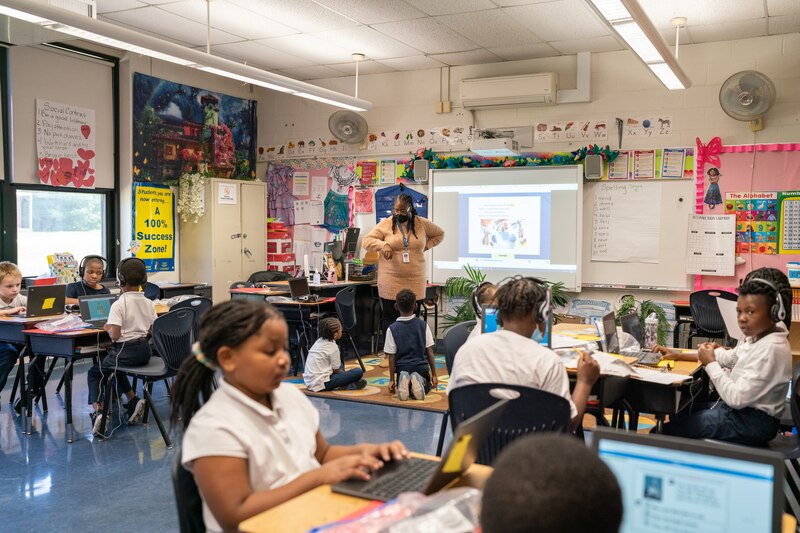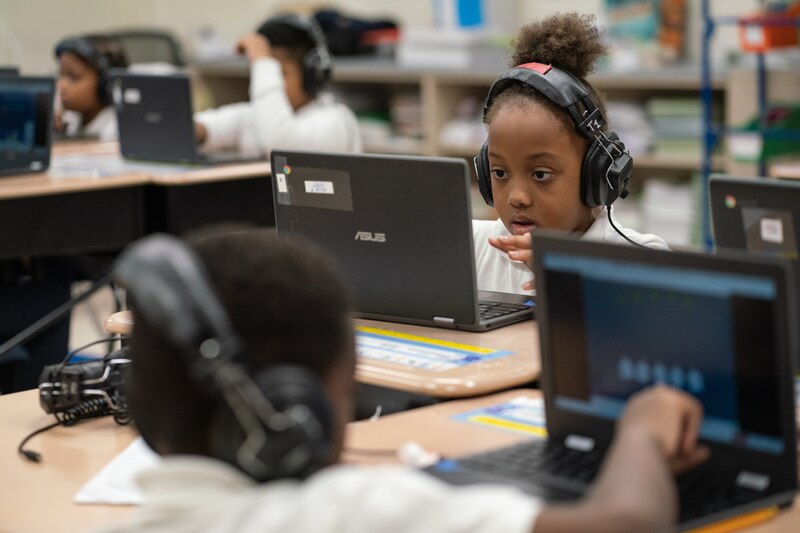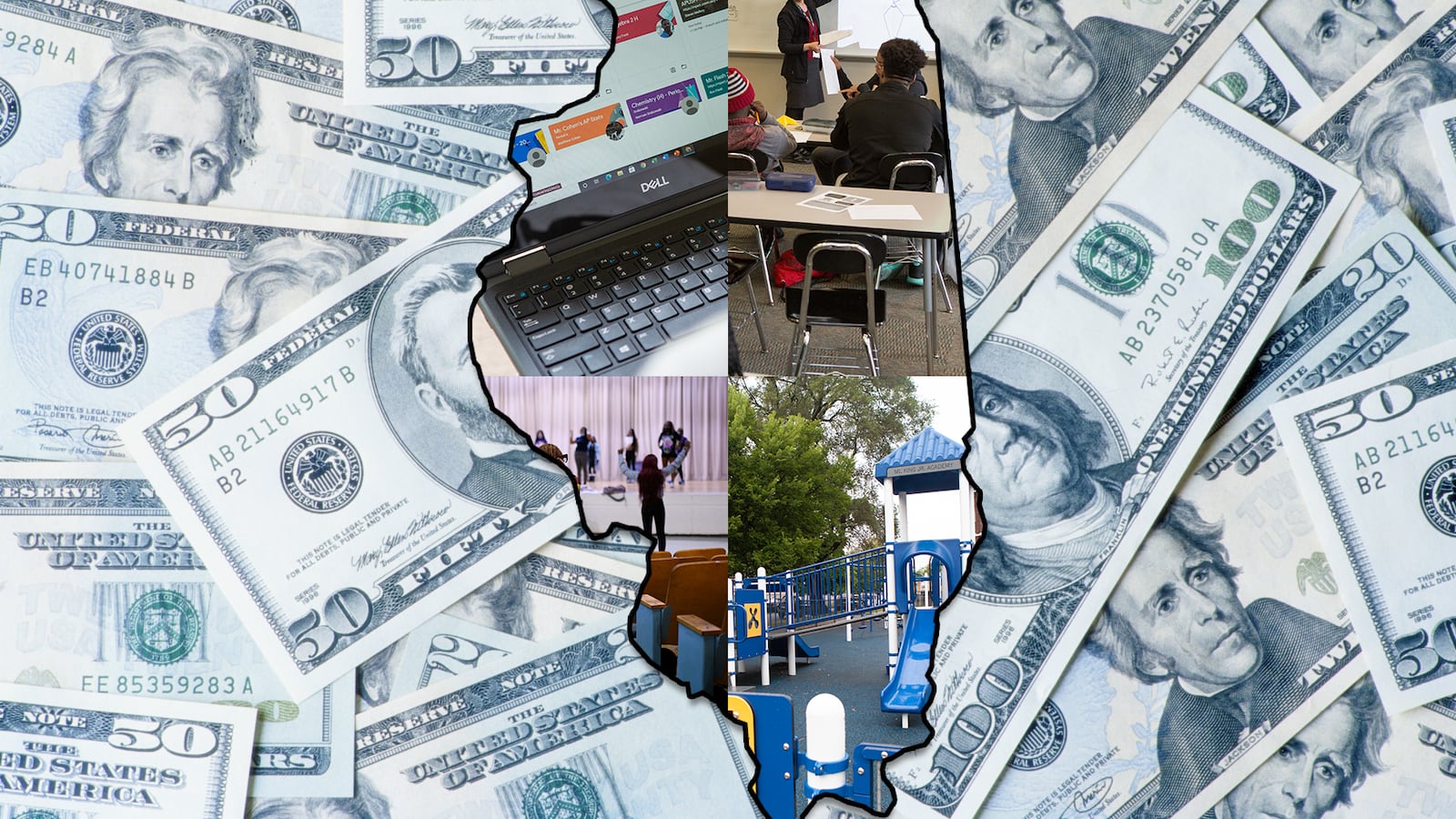Illinois school districts have received more than $7 billion in federal relief money to help reopen schools and ease the academic and mental health fallout from the COVID-19 pandemic.
But a Chalkbeat/Better Government Association analysis found that a slew of high-poverty districts across the state have spent small fractions of their relief funds, despite serving students who were especially hard hit by the pandemic. Many are in Chicago’s south suburbs, where almost a dozen districts have reported spending 15% or less of their federal dollars. Bloom Township, where 72% of almost 3,000 students are low-income, has spent only 6% of its $20 million allocation, according to state data.
Statewide, districts have spent about $2.8 billion of the total they received, as a federal fall 2024 deadline is looming.
High-poverty Illinois districts have spent a smaller portion – about 42% – of their Elementary and Secondary School Emergency Relief Fund, or ESSER, allocations than wealthier districts, which have spent roughly 60%, according to the Chalkbeat/BGA analysis of state records obtained through the Freedom of Information Act. These high-poverty districts received much more recovery money and have overall spent more per pupil than wealthier ones.
State officials have taken notice of the slow spending in some districts, but are not concerned.
Krish Mohip, the deputy operational education officer for the Illinois State Board of Education, said the state has reached out to some districts that have reported spending little of their allocations or haven’t yet submitted plans for the latest two of three COVID relief packages. But he said his agency is confident that — if districts aren’t spending the money briskly yet — they have solid plans to do so in the next couple of years. Spending is picking up this fall, he noted.
“With ESSER III, we still have a way to go, but we have a lot of time,” Mohip said. “We really don’t have concerns about the rate of spending right now.”

School leaders in the south suburban districts where the funds have been spent more slowly say they have confronted supply chain issues, hiring challenges, and other hurdles. Some said they have spent more briskly than state data suggests, but need to get caught up on reporting expenses.
Yet some education experts are questioning why some districts have been slower to spend their funds — emergency aid intended to help address the heightened academic and social-emotional needs of students. About 30% of Illinois students met reading state standards and about a quarter did in math this year, about 20% fewer students than in 2019, according to state data.
“If there are good ways to spend the money well right now, what are districts waiting for?” said Diane Whitmore Schanzenbach, director of the Institute for Policy Research at Northwestern University. “Kids have been hurt both academically and emotionally. We want to know what they are doing now to make kids whole.”
In Chicago’s south suburbs, spending is slow
Among the districts slowest to spend COVID money are a cluster of about 15 south suburban districts, which serve overwhelmingly low-income Black and Latino student populations. Those districts have spent 14% of their federal dollars on average. That’s about $1,200 per pupil – less than half the average amount for high-poverty districts statewide.
Almost 80% of students in these south suburban districts live in poverty. About 12% of their students met state standards in reading on the 2022 state report card and roughly 7% did in math, showing marked decreases in proficiency compared with pre-pandemic.
Brookwood School District 167, a district that serves 57% low-income students, has reported spending only 7% of its $6 million — or $449,228 — as of mid-September.
Brookwood Superintendent Bethany Lindsay said delays in the supply chain have been a factor, pointing to the delay in getting four vans the district purchased to transport students to field trips and community events.
“It took a year to receive them,” she said. “So we couldn’t claim that until we received them.”
Lindsay said the district has focused on removing obstacles that impact academic, social, and emotional learning for its more than 1,000 pre-K to eighth grade students. For example, the recently purchased vans help remove transportation barriers and expose students to new experiences, she said. In Brookwood, almost 17% of students met state standards in reading, and 6% did in math on the 2022 tests.
“The pandemic really showed that vulnerable populations were going to be most impaired because they have limited access to things already,” said Lindsay.
In addition to the vans, Brookwood has spent its money to adopt a two-to-one technology initiative that guarantees students have devices both at home and at school. The district also added another social worker to each of its four schools and has built two new playgrounds.
Lindsay said the district will share updated spending figures with the state in a quarterly expenditure report due at the end of October – a report required of all districts.
In the coming years, Lindsay said, the district will build a STEM and performing arts center to increase representation in those fields and to give students a place of creative expression.
“People can experience that for 100 years,” she said. “So it really stands for something in the community.”
Other south suburban district officials had varying reasons for the slow pace of spending. Some noted that school building repair projects took awhile to get off the ground; others said they are still figuring out what learning software to buy. One district, Dolton West, is holding on to the bulk of its ESSER money to undertake an uncommon plan to embrace hybrid learning next fall.
National experts say districts across the country have sometimes been slow to spend the federal money because they have grappled with how to make the best use of such a large windfall.
Many districts worry about having to lay off new hires and cut new programs when the one-time money runs out. Hiring shortages and supply chain issues have crimped some plans to spend the money, and these issues can be tougher for high-poverty districts, said Marguerite Roza of the Edunomics Lab at Georgetown University.
West Harvey-Dixmoor, where almost every student is low-income, has reported spending 13% of its federal COVID recovery money as of mid-September, according to state data. The district, where 7% of students met state standards in reading on the 2022 test and 3.5% did in math, earmarked a portion of the latest COVID package to address learning loss as required by the feds.
But the two interim superintendents, who stepped in at the end of 2021, made a plan to spend most of the district’s almost $17 million allocation on building projects.
“Our facilities haven’t actually been updated in close to 20 years,” said interim superintendent Creg Williams.
Williams said it took a while for the district to line up contractors and bring in materials and equipment to ramp up these projects, which include removing asbestos, upgrading ventilation systems and a school cafeteria, and refreshing flooring, doors, and student lockers. He said the district also launched an extended day learning program this school year and hired a dean of students and an instructional coach, and fall reporting to the state will reflect much additional spending.
In Hazel Crest, superintendent Kenneth Spells also said the district has spent more briskly than the 9% of the district’s $8.3 million allocation that state data shows, though he could not provide up-to-date amounts for how much his district has actually spent. In addition to spending on COVID mitigation measures, Spells said, the district has hired additional teachers so it could staff co-educators in some larger classrooms. It also paid existing staff to offer Saturday school for students needing additional academic help.
The district, where 99% of students are low-income, saw reading proficiency dip to about 9% in reading and 3.5% in math during the pandemic.
“We’re seeing some progress,” he said, “but it’s still early in the game.”
“Story is still being written”
The data obtained by Chalkbeat and the BGA shows all federal COVID relief expenditures reported by Illinois’ roughly 850 districts by mid-September, and is broken into five broad categories: capital projects, supplies and materials, employee salaries, benefits, and outside vendor contracts.
High-poverty districts have been more likely to put these federal funds into school facilities while wealthier ones have steered more dollars toward supplies and salaries.
Chicago has been an outlier among high-poverty districts in spending a large portion of its federal COVID relief dollars on salaries and benefits, largely for positions that already existed when the pandemic hit.
But beyond the broad categories, the state data offers little detail on what exactly districts bought with the money. And it doesn’t answer key questions, such as whether salary and benefit spending is for new or existing employees.
Jianan Shi, executive director of the parent advocacy group Raise Your Hand, says parents have generally wanted to see more urgency – and transparency – from districts in spending the federal money.
“We have seen districts small and large fail to be transparent and to include parents in decision-making,” he said.
What Shi consistently hears parents say they want to see: more outreach to reconnect with students and families who disengaged from learning during the pandemic; more staff in schools to support students; after-school programs; mental health support and tutoring.
Spending on facilities allows districts to use the one-time money without setting themselves up for layoffs or program cuts down the road, and some research has suggested a link between better school buildings and student learning.
Still, Shi said, “I don’t remember many parents saying, ‘Let’s just fix this issue in my facility with this money.’ We forget we are talking about students here.”
Mohip, of the state board of education, said his agency monitors the expenditure data districts submit closely, and staff has reached out to some districts to see if they need any help or guidance. He notes districts overwhelmingly met a recent federal deadline to spend the first wave of pandemic recovery money aimed at schools.
Some districts are holding on to the money for good reasons, he said. For instance, a district might have bought computers and other technology early in the pandemic, and might be waiting until closer to the end of the equipment’s life cycle to replace it. Others might still be working to fill new positions.
Ultimately, the money will make a difference, he said. “As of right now, that story is still being written. What we do know is that the money was needed and helpful at a time of distress.”

Other districts have spent COVID money briskly
Generally, the Chalkbeat/BGA analysis found, wealthier districts have spent their smaller funds briskly.
New Trier Township, for instance, has already burned through its $1.2 million allocation. The affluent school district in Chicago’s north suburbs serving nearly 3,850 students used the money for protective equipment, COVID testing, and other reopening expenditures. It also added two instructional assistants focused on math instruction and an academic interventionist.
But some high-poverty districts have also already spent most of the federal dollars.
Laraway, a small district about an hour southwest of downtown Chicago, has spent almost 80% of its $1.8 million allocation.
Superintendent Joe Salmieri said the district put some of the money toward hiring a teaching assistant for each elementary classroom to better target students who need more help.
“It was full-court press — all hands on deck,” said Salmieri. “Time is of the essence to address the negative effects of the pandemic.”
Initially, Salmieri said, the district struggled to recruit candidates, so it increased the pay and was able to fill most of the jobs this past summer.
The district, where almost all 450 students qualify for subsidized lunch, has also updated its math curriculum and ramped up after-school and summer programming. Salmieri said academic recovery is likely a “three-year journey.”
In Pembroke, an elementary district that serves 173 students, including 91% living in poverty, has spent 90% of the $3.4 million it received. Most of the money has been used on upgrading the single school building and tackling the pandemic’s academic damage, said Superintendent Nicole Terrell-Smith.
On the 2022 state tests, about 10% of students scored proficient in reading, and almost 11% did in math. To address this, Terrell-Smith has proposed that all students receive a personalized learning plan to help teachers tailor instruction to their academic needs. Currently, staff are getting professional development to help them to create these plans for the 2023-24 school year.
“I don’t want to have a beautiful facility but students who can’t read,” said Terrell-Smith.
Mila Koumpilova is Chalkbeat Chicago’s senior reporter covering Chicago Public Schools. Contact Mila at mkoumpilova@chalkbeat.org.
Jewél Jackson covers K-12 and higher education for the Better Government Association. Contact her at jjackson@bettergov.org

